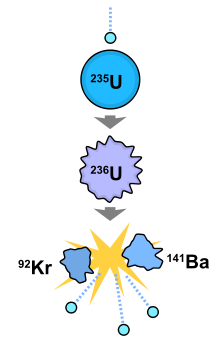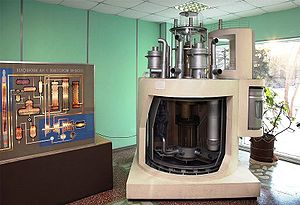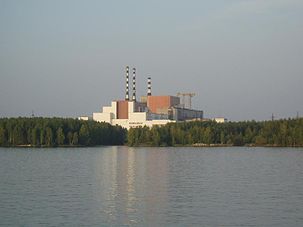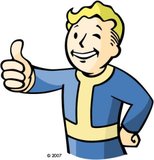Nuclear power - brief over Y
Judging by the comments on the post about the sky water, there is some misunderstanding of nuclear energy issues among readers. I want to bring some clarity to this question. To many, what I write will seem elementary, but, unfortunately, not to everyone.
The atomic nucleus is a very complex object from the point of view of physics. So complex that there is no unified theory that would describe the processes in the kernel. Nevertheless, there are theories that allow the use of nuclear energy for the benefit of mankind.
 There are different methods of obtaining energy from atomic nuclei. The simplest and most obvious is to use particles formed during the natural decay of radioactive nuclei. It turns out the battery on β-decay or α-decay. In one of the β-decay variants, an electron flies out of the nucleus, and the nuclear charge increases by one. By collecting electrons, you can get the potential difference between the substance in which the decay takes place and the electron collector. Such sources can potentially work for a very long time, but the power is small - tens of microwatts.
There are different methods of obtaining energy from atomic nuclei. The simplest and most obvious is to use particles formed during the natural decay of radioactive nuclei. It turns out the battery on β-decay or α-decay. In one of the β-decay variants, an electron flies out of the nucleus, and the nuclear charge increases by one. By collecting electrons, you can get the potential difference between the substance in which the decay takes place and the electron collector. Such sources can potentially work for a very long time, but the power is small - tens of microwatts.
 According to the law of conservation of momentum, when a particle flies out of the nucleus, the nucleus must acquire a pulse opposite in sign. At the macroscopic level, this means that the disintegrating substance is heated. Using this heat can generate electricity. A thermoelectric generator, vacuum or thermocouple, is coupled to the radioactive source. Semiconductor less effective, because degraded by ionizing radiation. Such sources were used at lighthouses along the northern sea route, the active radar system of the Legend MKRTS and probes to distant planets.
According to the law of conservation of momentum, when a particle flies out of the nucleus, the nucleus must acquire a pulse opposite in sign. At the macroscopic level, this means that the disintegrating substance is heated. Using this heat can generate electricity. A thermoelectric generator, vacuum or thermocouple, is coupled to the radioactive source. Semiconductor less effective, because degraded by ionizing radiation. Such sources were used at lighthouses along the northern sea route, the active radar system of the Legend MKRTS and probes to distant planets.
')
There are other methods, such as radioisotope optoelectric and radioisotope piezoelectric sources. Read more in Wikipedia: Radioisotope energy sources .
 A fundamentally different method of obtaining energy is carried out at power plants. There are conditions for nuclear fission. Natural isotopes decay by fission extremely rarely. However, there are isotopes, the nuclei of which can, having absorbed a neutron, turn into the nuclei of another isotope in the excited state. These nuclei decay by division with a very high probability and a short half-life. By controlling the conditions of the appearance of excited nuclei, it is possible to control the heat release in the reactor. To obtain optimal conditions for fission, different isotopes need neutrons with different energies. Conventionally, neutrons can be divided into slow - low-energy and fast, high-energy.
A fundamentally different method of obtaining energy is carried out at power plants. There are conditions for nuclear fission. Natural isotopes decay by fission extremely rarely. However, there are isotopes, the nuclei of which can, having absorbed a neutron, turn into the nuclei of another isotope in the excited state. These nuclei decay by division with a very high probability and a short half-life. By controlling the conditions of the appearance of excited nuclei, it is possible to control the heat release in the reactor. To obtain optimal conditions for fission, different isotopes need neutrons with different energies. Conventionally, neutrons can be divided into slow - low-energy and fast, high-energy.
In nature, of the isotopes suitable for the fission chain reaction, uranium-235 is most often found. By adding a slow neutron, the nucleus of uranium-235 turns into the nucleus of uranium-236 in an excited state. It can either emit a γ-quantum, or break up into two atoms of other elements and two or three fast neutrons. In order to pave the reaction you need to slow down the neutrons.
Thus, in the reactor there are four necessary substances: fuel, moderator (neutrons), control rods (neutron absorber) and coolant, to remove useful heat. Often the coolant and the moderator is the same substance - water. Most of the reactors at power plants, or rather all but one, work in precisely this principle. The fuel used is enriched uranium, with a high content of isotope 235. Two thirds of the energy is produced by dividing uranium-235, which is very small on earth, about the last third a little later.
 Can I fix the situation? Of course! For this there are fast-neutron reactors. The nuclei of uranium-238, of which natural uranium consists of more than 99%, absorb fast neutrons and turn into uranium-239, then into neptunium-239, and then into plutonium-239. In turn, plutonium-239 can absorb thermal neutrons and divides, just like uranium-235. In conventional reactors, plutonium-239 is also formed, and the last third of the thermal power is obtained from it.
Can I fix the situation? Of course! For this there are fast-neutron reactors. The nuclei of uranium-238, of which natural uranium consists of more than 99%, absorb fast neutrons and turn into uranium-239, then into neptunium-239, and then into plutonium-239. In turn, plutonium-239 can absorb thermal neutrons and divides, just like uranium-235. In conventional reactors, plutonium-239 is also formed, and the last third of the thermal power is obtained from it.
Fast neutron reactors are much more complex than conventional reactors. A sufficient number of fast neutrons is necessary, therefore the coolant should not slow down the neutrons and, naturally, absorb them. Currently, molten metals are used as coolants.
Lead is best suited. Firstly, it practically does not interact with neutrons, secondly, it absorbs γ-radiation, making it possible to make the biological protection of the reactor thinner. Lead deficiency - high melting point. What will happen to the reactor if lead hardens, for example, after automatic activation of the protection? Just so again to start the reactor is impossible. Lead will melt slowly and will not have time to remove heat from the warming up reactor. Bismuth is added to the lead to reduce the melting point. Such reactors are installed on our submarines.
At power plants, sodium or a eutectic mixture of sodium and potassium is used as a coolant. On the one hand, the leakage of alkali metal at 450 ° C is significantly worse than the leakage of lead with bismuth, on the other hand, the melting point is significantly lower. For sodium eutectic with potassium it is only 19 ° C.
 Generation IV International Forum (GIF) Formulated the concepts of fourth-generation atomic reactors. These reactors should go into commercial operation by 2030. Among them are fast neutron reactors. It was mentioned above that all reactors at all nuclear power plants except one, are currently operating on slow neutrons. Judging by the English Wikipedia, today there is only one fast neutron reactor in commercial operation. It works as part of the third power unit of the Beloyarsk NPP . In other words, the leader in the nuclear industry is Russia.
Generation IV International Forum (GIF) Formulated the concepts of fourth-generation atomic reactors. These reactors should go into commercial operation by 2030. Among them are fast neutron reactors. It was mentioned above that all reactors at all nuclear power plants except one, are currently operating on slow neutrons. Judging by the English Wikipedia, today there is only one fast neutron reactor in commercial operation. It works as part of the third power unit of the Beloyarsk NPP . In other words, the leader in the nuclear industry is Russia.
 The main advantage is the high energy intensity of the fuel, approximately 10 4 times more than that of hydrocarbons. This significantly reduces the cost of transporting fuel to power plants or electricity to consumers. At the same time, at the moment it is the most environmentally friendly way to generate electricity. Nuclear power plants pollute the environment mainly by heat emissions. It is not necessary here to remember about Chernobyl and Fukushima. These tragedies are largely echoes of the past, because the designs of reactors at both stations are outdated long ago. Waste disposal is indeed a challenge. However, if the fuel is measured in kilograms, there will also be little waste.
The main advantage is the high energy intensity of the fuel, approximately 10 4 times more than that of hydrocarbons. This significantly reduces the cost of transporting fuel to power plants or electricity to consumers. At the same time, at the moment it is the most environmentally friendly way to generate electricity. Nuclear power plants pollute the environment mainly by heat emissions. It is not necessary here to remember about Chernobyl and Fukushima. These tragedies are largely echoes of the past, because the designs of reactors at both stations are outdated long ago. Waste disposal is indeed a challenge. However, if the fuel is measured in kilograms, there will also be little waste.
There is another difficulty. Uranium-235 - unpromising fuel. It is not enough and it is necessary to enrich. Obviously, with the development of nuclear energy will be dominated by fast neutron reactors. And here a problem arises: it is quite difficult to get weapons-grade uranium-235 even from nuclear fuel - it is necessary to separate the isotopes of one substance. At the same time, it is relatively easy to obtain weapons-grade plutonium-239, because differences in the chemical properties of plutonium and uranium can be used. This means that the construction of modern nuclear power plants in many countries is significantly complicated.
The atomic nucleus is a very complex object from the point of view of physics. So complex that there is no unified theory that would describe the processes in the kernel. Nevertheless, there are theories that allow the use of nuclear energy for the benefit of mankind.
Portable nuclear power
 There are different methods of obtaining energy from atomic nuclei. The simplest and most obvious is to use particles formed during the natural decay of radioactive nuclei. It turns out the battery on β-decay or α-decay. In one of the β-decay variants, an electron flies out of the nucleus, and the nuclear charge increases by one. By collecting electrons, you can get the potential difference between the substance in which the decay takes place and the electron collector. Such sources can potentially work for a very long time, but the power is small - tens of microwatts.
There are different methods of obtaining energy from atomic nuclei. The simplest and most obvious is to use particles formed during the natural decay of radioactive nuclei. It turns out the battery on β-decay or α-decay. In one of the β-decay variants, an electron flies out of the nucleus, and the nuclear charge increases by one. By collecting electrons, you can get the potential difference between the substance in which the decay takes place and the electron collector. Such sources can potentially work for a very long time, but the power is small - tens of microwatts. According to the law of conservation of momentum, when a particle flies out of the nucleus, the nucleus must acquire a pulse opposite in sign. At the macroscopic level, this means that the disintegrating substance is heated. Using this heat can generate electricity. A thermoelectric generator, vacuum or thermocouple, is coupled to the radioactive source. Semiconductor less effective, because degraded by ionizing radiation. Such sources were used at lighthouses along the northern sea route, the active radar system of the Legend MKRTS and probes to distant planets.
According to the law of conservation of momentum, when a particle flies out of the nucleus, the nucleus must acquire a pulse opposite in sign. At the macroscopic level, this means that the disintegrating substance is heated. Using this heat can generate electricity. A thermoelectric generator, vacuum or thermocouple, is coupled to the radioactive source. Semiconductor less effective, because degraded by ionizing radiation. Such sources were used at lighthouses along the northern sea route, the active radar system of the Legend MKRTS and probes to distant planets.')
There are other methods, such as radioisotope optoelectric and radioisotope piezoelectric sources. Read more in Wikipedia: Radioisotope energy sources .
Chain reaction
 A fundamentally different method of obtaining energy is carried out at power plants. There are conditions for nuclear fission. Natural isotopes decay by fission extremely rarely. However, there are isotopes, the nuclei of which can, having absorbed a neutron, turn into the nuclei of another isotope in the excited state. These nuclei decay by division with a very high probability and a short half-life. By controlling the conditions of the appearance of excited nuclei, it is possible to control the heat release in the reactor. To obtain optimal conditions for fission, different isotopes need neutrons with different energies. Conventionally, neutrons can be divided into slow - low-energy and fast, high-energy.
A fundamentally different method of obtaining energy is carried out at power plants. There are conditions for nuclear fission. Natural isotopes decay by fission extremely rarely. However, there are isotopes, the nuclei of which can, having absorbed a neutron, turn into the nuclei of another isotope in the excited state. These nuclei decay by division with a very high probability and a short half-life. By controlling the conditions of the appearance of excited nuclei, it is possible to control the heat release in the reactor. To obtain optimal conditions for fission, different isotopes need neutrons with different energies. Conventionally, neutrons can be divided into slow - low-energy and fast, high-energy.In nature, of the isotopes suitable for the fission chain reaction, uranium-235 is most often found. By adding a slow neutron, the nucleus of uranium-235 turns into the nucleus of uranium-236 in an excited state. It can either emit a γ-quantum, or break up into two atoms of other elements and two or three fast neutrons. In order to pave the reaction you need to slow down the neutrons.
Nuclear power plants
Thus, in the reactor there are four necessary substances: fuel, moderator (neutrons), control rods (neutron absorber) and coolant, to remove useful heat. Often the coolant and the moderator is the same substance - water. Most of the reactors at power plants, or rather all but one, work in precisely this principle. The fuel used is enriched uranium, with a high content of isotope 235. Two thirds of the energy is produced by dividing uranium-235, which is very small on earth, about the last third a little later.
 Can I fix the situation? Of course! For this there are fast-neutron reactors. The nuclei of uranium-238, of which natural uranium consists of more than 99%, absorb fast neutrons and turn into uranium-239, then into neptunium-239, and then into plutonium-239. In turn, plutonium-239 can absorb thermal neutrons and divides, just like uranium-235. In conventional reactors, plutonium-239 is also formed, and the last third of the thermal power is obtained from it.
Can I fix the situation? Of course! For this there are fast-neutron reactors. The nuclei of uranium-238, of which natural uranium consists of more than 99%, absorb fast neutrons and turn into uranium-239, then into neptunium-239, and then into plutonium-239. In turn, plutonium-239 can absorb thermal neutrons and divides, just like uranium-235. In conventional reactors, plutonium-239 is also formed, and the last third of the thermal power is obtained from it.Fast neutron reactors are much more complex than conventional reactors. A sufficient number of fast neutrons is necessary, therefore the coolant should not slow down the neutrons and, naturally, absorb them. Currently, molten metals are used as coolants.
Lead is best suited. Firstly, it practically does not interact with neutrons, secondly, it absorbs γ-radiation, making it possible to make the biological protection of the reactor thinner. Lead deficiency - high melting point. What will happen to the reactor if lead hardens, for example, after automatic activation of the protection? Just so again to start the reactor is impossible. Lead will melt slowly and will not have time to remove heat from the warming up reactor. Bismuth is added to the lead to reduce the melting point. Such reactors are installed on our submarines.
At power plants, sodium or a eutectic mixture of sodium and potassium is used as a coolant. On the one hand, the leakage of alkali metal at 450 ° C is significantly worse than the leakage of lead with bismuth, on the other hand, the melting point is significantly lower. For sodium eutectic with potassium it is only 19 ° C.
 Generation IV International Forum (GIF) Formulated the concepts of fourth-generation atomic reactors. These reactors should go into commercial operation by 2030. Among them are fast neutron reactors. It was mentioned above that all reactors at all nuclear power plants except one, are currently operating on slow neutrons. Judging by the English Wikipedia, today there is only one fast neutron reactor in commercial operation. It works as part of the third power unit of the Beloyarsk NPP . In other words, the leader in the nuclear industry is Russia.
Generation IV International Forum (GIF) Formulated the concepts of fourth-generation atomic reactors. These reactors should go into commercial operation by 2030. Among them are fast neutron reactors. It was mentioned above that all reactors at all nuclear power plants except one, are currently operating on slow neutrons. Judging by the English Wikipedia, today there is only one fast neutron reactor in commercial operation. It works as part of the third power unit of the Beloyarsk NPP . In other words, the leader in the nuclear industry is Russia.Nuclear power outside
 The main advantage is the high energy intensity of the fuel, approximately 10 4 times more than that of hydrocarbons. This significantly reduces the cost of transporting fuel to power plants or electricity to consumers. At the same time, at the moment it is the most environmentally friendly way to generate electricity. Nuclear power plants pollute the environment mainly by heat emissions. It is not necessary here to remember about Chernobyl and Fukushima. These tragedies are largely echoes of the past, because the designs of reactors at both stations are outdated long ago. Waste disposal is indeed a challenge. However, if the fuel is measured in kilograms, there will also be little waste.
The main advantage is the high energy intensity of the fuel, approximately 10 4 times more than that of hydrocarbons. This significantly reduces the cost of transporting fuel to power plants or electricity to consumers. At the same time, at the moment it is the most environmentally friendly way to generate electricity. Nuclear power plants pollute the environment mainly by heat emissions. It is not necessary here to remember about Chernobyl and Fukushima. These tragedies are largely echoes of the past, because the designs of reactors at both stations are outdated long ago. Waste disposal is indeed a challenge. However, if the fuel is measured in kilograms, there will also be little waste.There is another difficulty. Uranium-235 - unpromising fuel. It is not enough and it is necessary to enrich. Obviously, with the development of nuclear energy will be dominated by fast neutron reactors. And here a problem arises: it is quite difficult to get weapons-grade uranium-235 even from nuclear fuel - it is necessary to separate the isotopes of one substance. At the same time, it is relatively easy to obtain weapons-grade plutonium-239, because differences in the chemical properties of plutonium and uranium can be used. This means that the construction of modern nuclear power plants in many countries is significantly complicated.
Source: https://habr.com/ru/post/143148/
All Articles